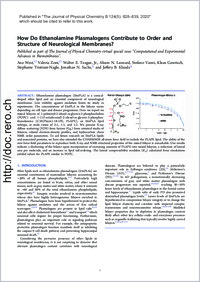How do ethanolamine plasmalogens contribute to order and structure of neurological membranes?
- West, Ana Department of Chemistry, University of Georgia, Athens, Georgia 30602, United States
- Zoni, Valeria Department of Biology, University of Fribourg, 1700 Fribourg, Switzerland
- Teague, Walter E. Laboratory of Membrane Biochemistry and Biophysics, National Institute on Alcohol Abuse and Alcoholism, NIH, Bethesda, Maryland 20892, United States
- Leonard, Alison N. Biophysics Graduate Program, University of Maryland, College Park, Maryland 20742, United States
- Vanni, Stefano Department of Biology, University of Fribourg, 1700 Fribourg, Switzerland
- Gawrisch, Klaus Laboratory of Membrane Biochemistry and Biophysics, National Institute on Alcohol Abuse and Alcoholism, NIH, Bethesda, Maryland 20892, United States
- Tristram-Nagle, Stephanie Biological Physics Group, Physics Department, Carnegie Mellon University, Pittsburgh, Pennsylvania 15213, United States
- Sachs, Jonathan N. Department of Biomedical Engineering, University of Minnesota, Twin Cities, Minnesota 55455, United States
- Klauda, Jeffery B. Biophysics Graduate Program, University of Maryland, College Park, Maryland 20742, United States - Department of Chemical and Biomolecular Engineering, University of Maryland, College Park, Maryland 20742, United States
-
06.02.2020
Published in:
- The Journal of Physical Chemistry B. - 2020, vol. 124, no. 5, p. 828–839
English
Ethanolamine plasmalogen (EtnPLA) is a conical-shaped ether lipid and an essential component of neurological membranes. Low stability against oxidation limits its study in experiments. The concentration of EtnPLA in the bilayer varies depending on cell type and disease progression. Here we report on mixed bilayers of 1-palmitoyl-2-oleoyl-sn-glycero-3-phosphocholine (POPC) and 1-(1Z- octadecenyl)-2-oleoyl-sn-glycero-3-phosphoethanolamine (C18(Plasm)-18:1PE, PLAPE), an EtnPLA lipid subtype, at mole ratios of 2:1, 1:1, and 1:2. We present X-ray diffuse scattering (XDS) form factors F(qz) from oriented stacks of bilayers, related electron-density profiles, and hydrocarbon chain NMR order parameters. To aid future research on EtnPLA lipids and associated proteins, we have also extended the CHARMM36 all-atom force field to include the PLAPE lipid. The ability of the new force-field parameters to reproduce both X- ray and NMR structural properties of the mixed bilayer is remarkable. Our results indicate a thickening of the bilayer upon incorporation of increasing amounts of PLAPE into mixed bilayers, a reduction of lateral area per molecule, and an increase in lipid tail-ordering. The lateral compressibility modulus (KA) calculated from simulations yielded values for PLAPE similar to POPC.
- Faculty
- Faculté des sciences et de médecine
- Department
- Département de Biologie
- Language
-
- English
- Classification
- Biological sciences
- License
-
License undefined
- Identifiers
-
- RERO DOC 328408
- DOI 10.1021/acs.jpcb.9b08850
- Persistent URL
- https://folia.unifr.ch/unifr/documents/308451
Other files
Statistics
Document views: 122
File downloads:
- pdf: 231
- Supplementary material: 182

